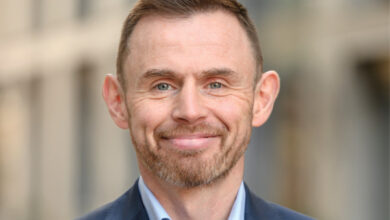Edelman’s Robin Hamman discusses meaningful social media
 Using social media strategically can help organisations understand their audiences and develop new business. Edelman’s digital expert Robin Hamman talks to Peter Cheney about its potential.
Using social media strategically can help organisations understand their audiences and develop new business. Edelman’s digital expert Robin Hamman talks to Peter Cheney about its potential.
There is little point in ‘doing’ social media if it does not meet your business objectives, according to Robin Hamman. Too many organisations are ending up with a presence that’s not interesting and does not help its audience.
“It is about the user,” he states. “It needs to be meaningful and it needs to result in measurable outcomes.”
Robin Hamman is Director of Digital at the London office of global PR firm Edelman. Born in Illinois, Hamman was previously the BBC’s Senior Community Producer, teaching BBC staff how to engage new audiences online.
The aim of his work in broadcasting was to bring audiences closer to programme-makers and editors by “letting them ask questions, point to facts or people that they think might be interesting within the story, and providing feedback once that story has gone out.”
He realised that this approach could be applied elsewhere: “People with skills like this, skills to seek out and engage directly with audiences and stakeholders, are becoming increasingly important within businesses.”
Hamman adds: “It’s not just about describing products and services that already exist, and then trying to flog those. It’s increasingly about understanding what audiences and stakeholders want and getting the business to actually point itself in the direction to fulfil those needs.”
Edelman sees the world of digital as three “different but interconnected” spheres: own, social and search.
The first sphere includes the corporate website which puts forward the organisation’s views “but in most instances it does very little to attract people who don’t know about you already or to meet their needs.”
In social media, people participate “across the web wherever they choose to”. The ‘social media embassy’ is a concept that sits between those two spheres. This is a brand- or organisationally-controlled presence in social media. It’s not owned by the brand but, like a real world embassy, offers a door for constituents or stakeholders to “knock on”.
Hamman continues: “People are increasingly spending time in social media and, rather than trying to attract them and bring them across to their organisational website, it’s a lot easier to be out there participating, where they might stumble into you and then engage.” Links from other websites or in online discussions will raise a company’s search visibility on Google.
To look at it in another way, brands and companies exist in a “multi-stakeholder ecosystem”. Those stakeholders include the media, investors, regulators, unions, employees, customers and potential recruits.
However, organisations tend to silo their activities into different departments (marketing, sales, recruitment etc.) with each one having its own budget, digital systems and internal processes. He describes that space between the silos as the “gulf of organisational complexity” and social media can help to cut through it.
“With the tools available, it is possible to understand what your audiences and stakeholders want from you, to respond to them, to engage them in coming up with new products and services, or indeed to get them to assist you when a problem does arise,” Hamman remarks.
On the last point, social media allows companies to create spaces where customers can help other customers to overcome their problems with a service or product.
When approaching social media, businesses must recognise that all staff are representatives of the brand. The average person on the street does not see the person to whom they have spoken as a ‘someone in recruitment or marketing’ but instead sees “all one business.”
Businesses can “harness” how employees talk about their jobs online (e.g. via facebook): “Most of the time it’s positive, sometimes it’s neutral and occasionally it’s negative.”
First and foremost, this means having social media guidelines. As an extension, a brand can encourage its staff to communicate with their own networks on its behalf.
PepsiCo, for example, employs around 150,000 employees globally. He suggests that getting even a small percentage of those employees to “communicate on behalf of the brand in a way that’s contextually relevant” to their friends would have a “multiplication effect”. The employee would share that message with audiences that have similar interests to him or her.
From an historical perspective, social media brings back one-to-one contact between businesses and their stakeholders or consumers.
“Over the last 50-100 years [there] has been a time of mass production, mass communication and mass consumption,” he reflects. “You still get the benefits of doing things at a mass scale but you can engage directly one-to-one with those audiences and consumers. It’s quite interesting what that allows businesses to do.”
Customers and stakeholders are potentially “much happier” and engagement “helps them feel part of what the business or organisation is trying to achieve.”
Edelman promotes “digital public engagement” and “meaningful participatory frameworks” that align the behaviour of stakeholders with measurable business outcomes. Relevant questions include: “Who is my audience? What do they want to achieve? How can I help them to achieve it? And then how does that meet my business objectives?”
The BBC, for example, learnt lessons from its initial audience forums. Viewers and listeners were asked to simply ‘have their say’ on programmes. This resulted in “a flood of content that was oftentimes inappropriate or low quality or not relevant”.
Better results came when the audience was asked a specific question e.g. whether they knew someone who had experienced a particular medical condition and might like to be interviewed about it. Two or three people came forward; the contact was useful for them and the broadcaster.
“When you look at social media more broadly,” he surmises. “It can look like anarchy and where it’s interesting is where it’s doing something meaningful.”





